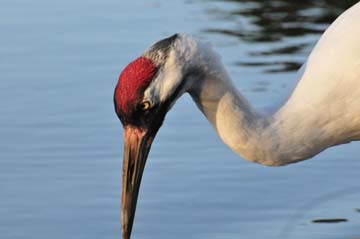Recovery

Whooping cranes have been reintroduced into Wisconsin to help recover the species.
Photo by USFWS; Joel Trick |
Recovery is the process used to restore threatened and
endangered species to the point that protection under
the Endangered Species Act is no longer needed.
Narrated Recovery Slideshow - provides a brief overview of Section 4 of the Endangered Species Act which includes Listing and Recovery.
Recovery Reports to Congress
Fiscal Years 2009-2010 [3.1MB]
Fiscal Years 2007-2008 [1.0MB]
Fiscal Years 2005-2006 [3.0MB]
Narrative Summary of Recovery Actions During 2005-2006 [2.2MB]
Fiscal Years 2003-2004 [3.1MB]
Fiscal Years 2001-2002 [5.3MB]
Fiscal Years 1998-2000 [5.5MB]
1996 [588KB]
1994 [7.9MB]
Below are the steps and actions we take to recover
listed species:
• Planning: Prepare recovery outlines and recovery
plans for listed species. This is the planning portion of the
recovery process. A recovery outline is the foundation for a Recovery
Plan. Recovery Plans identify and prioritize actions necessary
to conserve the subject species. Recovery Plans also provide information
about the species life history, habitat requirements, and threats.
• Conservation Activities: Carry out the actions identified in Recovery
Plans. We and many partners collaborate to carry out the actions
identified in Recovery Plans. Species-specific conservation actions can be found by going to the list of species found in the Upper Midwest and click on the species common name.
• Issue Recovery Permits: Recovery permits allow people to work with or on
listed species, either in a research capacty or for specific management
purposes. Actions that are permitted must improve our capability
to recover listed species.
• Monitor: Conduct status assessments, such as 5-year
reviews, to monitor the population health of species and threats
to their existence.
• Change Species ESA Status: We reclassify species from endangered to
threatened as a species population health improves or reclassify
from threatened to endangered as a species population health declines
or threats increase. We delist species (i.e., remove from the
list of threatened and endangered species) when their status improves
to the point of recovery. Recovery is measured not only by population
health, but also by assurance that threats are addressed.
Missouri bladderpod was changed from endangered to threatened

• Delist: After a species has recovered and is delisted,
we monitor that species for a minimum of 5 years to ensure its
lasting stability.
Bald
Eagle
Peregrine Falcon
Links to more information about Recovery:
Our
National Endangered Species Recovery website has more detailed
information about the Recovery process, including policies and guidances.
Recovery Plans for species
found in the upper Midwest (Region 3)
5-Year Reviews for species
found in the upper Midwest (Region 3)
Recovery Permits for species found in the upper Midwest (Region 3)
View the list
of all threatened and endangered species in the upper Midwest (Region
3). Follow the species links for more information.
Midwest Endangered Species Home





